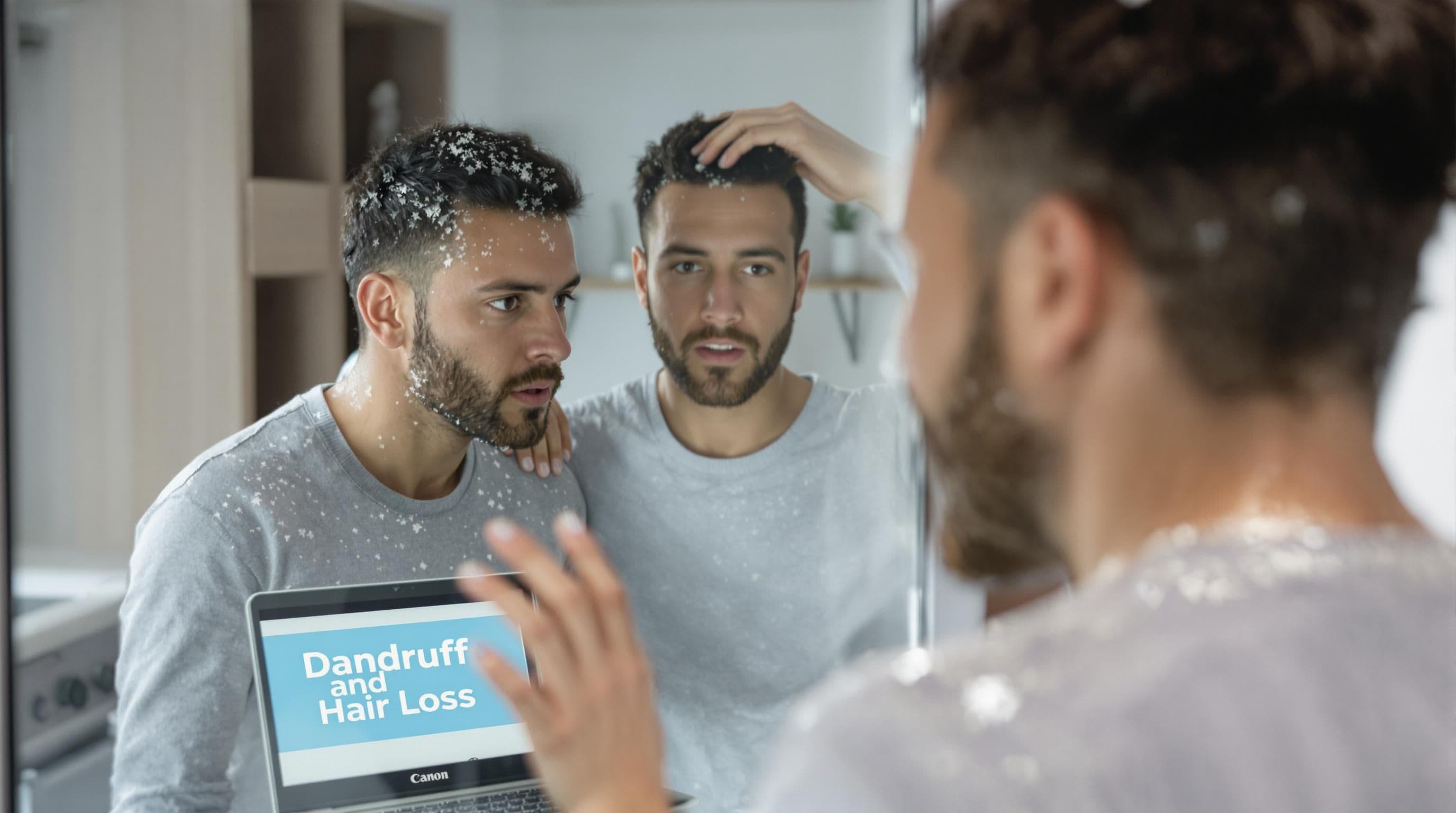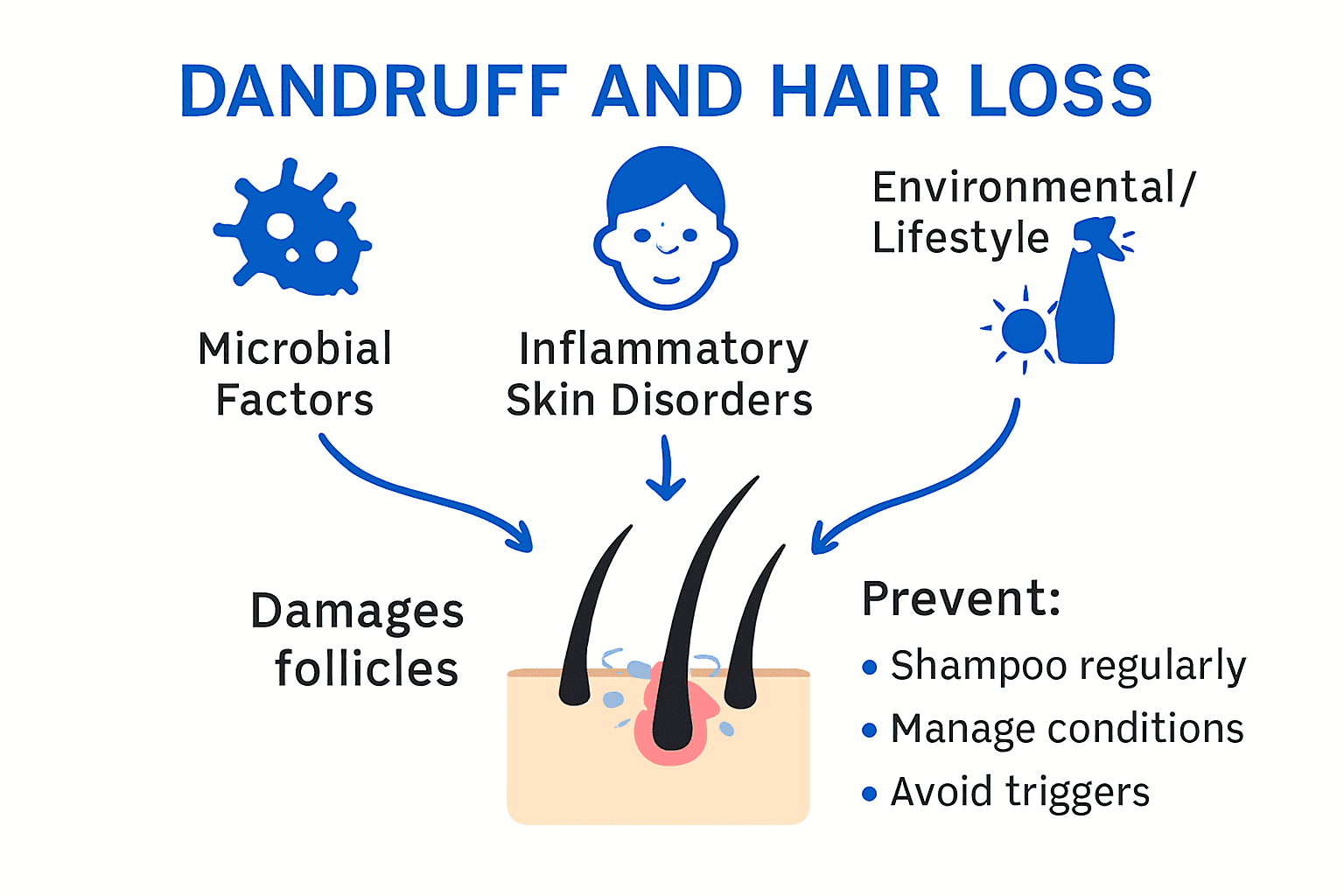Blog
Learning Materials
Dandruff and Hair Loss: Causes, Prevention, and Solutions 2025
Updated: July 30, 2025

Dandruff might seem like just a flaky inconvenience, but its influence runs much deeper than a few white specks on your shirt. You might be surprised to learn that persistent dandruff can weaken hair roots and disrupt growth cycles, leading to increased shedding. The real shock is how closely scalp health and hair thickness are tied together, and most people miss these hidden red flags until the damage is already done.
Table of Contents
- Understanding The Link Between Dandruff And Hair Loss
- Common Causes And Scalp Conditions Explained
- Effective Ways To Prevent And Treat Hair Loss
- Personalized Hair Care And Growth Tracking Solutions
Quick Summary
| Takeaway | Explanation |
|---|---|
| Dandruff impacts hair loss significantly | Persistent dandruff can weaken hair roots and disrupt growth cycles, leading to increased shedding. |
| Scalp health management is crucial | Regular cleansing, moisture maintenance, and early intervention can prevent long-term hair damage. |
| Identify and address underlying conditions | Understanding microbial and inflammatory scalp conditions helps target effective treatments for hair health. |
| Personalized hair care strategies improve outcomes | Tailored approaches based on individual diagnostics yield better hair growth results and minimize loss. |
| Innovative treatments can restore hair | Advanced technologies and therapies offer new ways to stimulate hair growth and enhance scalp health. |
Understanding the Link Between Dandruff and Hair Loss
Dandruff and hair loss are more interconnected than most people realize. These seemingly separate scalp conditions can significantly impact hair health and growth, creating a complex relationship that demands careful understanding.
The Scalp Ecosystem and Hair Damage
The human scalp is a delicate ecosystem where multiple factors interact to influence hair growth and health. Research from the Journal of Clinical and Aesthetic Dermatology reveals that an overgrowth of Malassezia yeast can trigger inflammatory responses leading to scalp damage. This microorganism plays a critical role in dandruff development and can potentially compromise hair follicle integrity.
Oxidative stress generated by scalp inflammation creates an environment hostile to healthy hair growth. When dandruff persists, it can weaken hair roots, increase breakage, and disrupt the normal hair growth cycle. The constant irritation and flaking can damage hair follicles, making them more susceptible to premature shedding.
Inflammatory Mechanisms and Hair Loss
A clinical study published in medical research demonstrates that persistent scalp inflammation associated with dandruff can directly impact hair growth mechanisms. When the scalp experiences chronic inflammation, it triggers stress responses that can push hair follicles into premature resting phases, reducing overall hair density.
The inflammatory process disrupts normal hair growth patterns by:
- Reducing nutrient delivery to hair follicles
- Increasing scalp sensitivity and potential damage
- Interrupting natural hair regeneration cycles
Individuals experiencing persistent dandruff should recognize these potential long term consequences. The connection between scalp health and hair growth is not merely cosmetic but deeply physiological.
Managing Scalp Health to Prevent Hair Loss
Addressing dandruff is not just about eliminating visible flakes but protecting overall hair health. Our comprehensive hair growth tracking can help users understand their unique scalp conditions and potential risk factors.
Effective management involves a holistic approach that includes:
- Regular scalp cleansing with targeted antifungal treatments
- Maintaining proper scalp moisture balance
- Reducing inflammation through specialized hair care strategies
- Monitoring scalp health for early intervention
Understanding the intricate relationship between dandruff and hair loss empowers individuals to take proactive steps in maintaining robust hair health. By recognizing warning signs and implementing strategic interventions, one can mitigate potential long term damage and preserve hair quality.
Common Causes and Scalp Conditions Explained

Understanding the various scalp conditions that contribute to dandruff and potential hair loss requires a comprehensive exploration of underlying factors. Multiple physiological and environmental triggers can disrupt scalp health and create complex challenges for individuals experiencing these symptoms.
Microbial Triggers and Fungal Interactions
Research from the Mayo Clinic reveals that dandruff often emerges from specific microbial interactions. The Malassezia yeast, naturally present on human scalps, can proliferate and cause significant scalp irritation when environmental conditions become favorable. This microscopic organism feeds on scalp oils, potentially triggering inflammatory responses that disrupt normal hair growth patterns.
Certain individuals exhibit heightened sensitivity to Malassezia, experiencing more aggressive scalp reactions. Factors like hormonal changes, stress, and immune system variations can amplify the yeast's impact, leading to increased flaking and potential follicular damage. Our guide on tracking hair health can help users understand these nuanced interactions.
Inflammatory Skin Conditions and Scalp Disorders
Clinical research from the National Center for Biotechnology Information highlights several inflammatory conditions that contribute to scalp complications. Seborrheic dermatitis represents a prime example of a complex scalp disorder characterized by intense inflammation and increased skin cell turnover. This condition is particularly sensitive to environmental changes, with factors like humidity, seasonal shifts, and emotional stress potentially exacerbating symptoms.
Other significant scalp conditions impacting hair health include:
- Psoriasis: An autoimmune condition causing rapid skin cell production
- Eczema: Characterized by intense itching and inflammatory responses
- Tinea capitis: A fungal infection directly affecting hair follicles
These conditions share common mechanisms of scalp inflammation that can compromise hair follicle integrity and potentially accelerate hair loss processes.
Environmental and Lifestyle Factors
Beyond microbial and physiological triggers, external factors play a crucial role in scalp health. Diet, stress levels, hormonal balance, and personal hygiene practices significantly influence dandruff development and potential hair loss. Nutritional deficiencies, prolonged stress, and improper hair care routines can create an environment conducive to scalp disruptions.
Key lifestyle considerations include:
- Maintaining balanced nutrition
- Managing stress through holistic approaches
- Using appropriate hair care products
- Avoiding excessive heat and chemical treatments
- Practicing consistent scalp hygiene
Recognizing these multifaceted causes empowers individuals to develop targeted strategies for managing scalp health. By understanding the intricate interactions between biological, environmental, and personal factors, one can make informed decisions about hair and scalp care.
Below is a summary table highlighting scalp disorders mentioned, their causes, and impact on hair health to help readers differentiate between them:
| Scalp Condition | Main Cause | Impact on Hair Health |
|---|---|---|
| Dandruff | Overgrowth of Malassezia yeast | Flaking, can weaken roots, increase shedding |
| Seborrheic Dermatitis | Inflammatory response, yeast | Inflammation, increased skin cell turnover, follicle damage |
| Psoriasis | Autoimmune, rapid cell production | Plaques, inflammation, possible hair loss |
| Eczema | Inflammatory/immune triggers | Itching, inflammation, possible weakening of follicles |
| Tinea Capitis | Fungal infection | Direct follicle attack, can lead to hair loss |
Effective Ways to Prevent and Treat Hair Loss
Addressing hair loss requires a multifaceted approach that combines medical treatments, lifestyle modifications, and proactive scalp care. Understanding and implementing targeted strategies can significantly mitigate hair loss progression and promote healthier hair growth.
Medical Interventions and Pharmaceutical Treatments
Research from the Cleveland Clinic highlights several medical interventions for hair loss management. Pharmaceutical treatments like minoxidil and finasteride represent primary pharmacological approaches. Minoxidil, an over-the-counter topical solution, stimulates hair follicle activity and can help maintain existing hair while potentially encouraging regrowth.
Finasteride, typically prescribed for male pattern baldness, works by blocking testosterone conversion into dihydrotestosterone (DHT), a hormone responsible for hair follicle shrinkage. These medications require consistent application and professional medical supervision to ensure optimal results.
Emerging treatments such as low-level laser therapy and platelet-rich plasma (PRP) therapy offer innovative approaches to hair restoration. Our comprehensive hair care guide provides deeper insights into these advanced treatment modalities.
Holistic Prevention and Lifestyle Strategies
Recommendations from the American Academy of Dermatology emphasize the importance of holistic prevention strategies. Gentle hair care practices play a crucial role in minimizing hair loss and maintaining scalp health.
Key lifestyle and prevention strategies include:
- Nutrition: Consuming protein-rich foods and essential vitamins
- Stress Management: Implementing relaxation techniques
- Hair Care: Using mild, sulfate-free shampoos
- Scalp Protection: Avoiding excessive heat and chemical treatments
Nutritional supplements containing biotin, zinc, and iron can support hair follicle health. These nutrients contribute to stronger hair growth and potentially reduce breakage and hair loss.
Advanced Scalp and Hair Restoration Techniques
For individuals experiencing significant hair loss, advanced restoration techniques offer promising solutions. Follicular unit transplantation (FUT) and follicular unit extraction (FUE) represent sophisticated surgical methods for hair restoration.
These procedures involve transplanting healthy hair follicles from dense areas to regions experiencing thinning. Modern techniques ensure natural-looking results with minimal scarring. However, these interventions require thorough consultation with specialized dermatologists or hair restoration experts.
Comprehensive hair loss management demands a personalized approach. Individuals should consult healthcare professionals to develop tailored strategies addressing their specific hair loss patterns, underlying conditions, and genetic predispositions.
By combining medical treatments, lifestyle modifications, and advanced restoration techniques, individuals can effectively combat hair loss and promote long term scalp and hair health. Early intervention and proactive management remain the most critical factors in successful hair loss prevention and treatment.
Below is a comparison table summarizing main hair loss treatment approaches, their mechanisms, and typical uses as discussed in this section:
| Treatment Approach | Mechanism/Technique | Typical Use |
|---|---|---|
| Minoxidil (Topical) | Stimulates hair follicle activity | General thinning, early hair loss (OTC) |
| Finasteride (Oral) | Blocks DHT formation | Male pattern baldness (prescription) |
| Low-Level Laser Therapy | Light energy stimulates growth | Adjunctive therapy, medical offices/home devices |
| Platelet-Rich Plasma (PRP) Therapy | Concentrated growth factors injected into scalp | Promote regrowth in thinning areas |
| FUT/FUE Hair Transplant | Transplantation of healthy follicles | Significant/refractory hair loss, surgical clinics |
Personalized Hair Care and Growth Tracking Solutions
Personalized hair care represents a revolutionary approach to addressing individual scalp and hair health challenges. As technology advances, individuals now have unprecedented opportunities to understand and manage their unique hair growth patterns with precision and scientific insight.
Advanced Diagnostic Technologies
Researchers at Washington State University have developed cutting-edge AI-based technologies that enable high-resolution hair analysis. These innovative tools can rapidly quantify complex hair attributes including color, shape, width, and length, providing unprecedented insights into individual hair characteristics.
Modern diagnostic approaches move beyond traditional visual assessments, incorporating sophisticated imaging techniques and algorithmic analysis. Our comprehensive hair tracking solutions leverage these advanced technologies to offer users detailed, personalized hair health assessments.
Key diagnostic parameters now include:
- Follicle Density: Precise measurement of hair follicle concentration
- Hair Thickness: Quantitative analysis of individual hair strand width
- Growth Rate: Tracking longitudinal hair growth patterns
- Scalp Health: Comprehensive evaluation of underlying scalp conditions
Personalized Treatment Strategies

A groundbreaking study published in PubMed outlines standardized methodologies for assessing hair growth in individuals with specific hair disorders. These advanced techniques enable healthcare professionals to develop highly targeted treatment approaches based on individual genetic, environmental, and physiological factors.
Personalization now extends beyond generic recommendations, incorporating:
- Genetic Profiling: Understanding hereditary hair loss predispositions
- Microbiome Analysis: Evaluating scalp bacterial and fungal interactions
- Hormonal Assessments: Tracking metabolic and endocrine influences on hair health
- Nutritional Mapping: Identifying specific dietary interventions
Innovative Growth Stimulation Technologies
Researchers at the University of Wisconsin-Madison have introduced groundbreaking wearable technologies that stimulate hair regrowth. These devices harness body movement to deliver gentle electric pulses, potentially reactivating dormant hair follicles through non-invasive mechanisms.
Emerging technologies in hair restoration focus on:
- Bioelectric Stimulation: Using controlled electrical impulses
- Nanotechnology: Developing targeted molecular interventions
- Regenerative Medicine: Exploring stem cell and growth factor treatments
- Adaptive Monitoring: Creating real-time hair health tracking systems
The future of hair care lies in understanding individual complexity. By integrating advanced diagnostic technologies, personalized treatment strategies, and innovative growth stimulation techniques, individuals can now access unprecedented levels of hair health management. These solutions transform hair care from a reactive approach to a proactive, scientifically informed journey of personal wellness and restoration.
Frequently Asked Questions
What is the relationship between dandruff and hair loss?
Persistent dandruff can weaken hair roots and disrupt hair growth cycles, leading to increased shedding. Proper scalp health is crucial for maintaining healthy hair.
How can I manage dandruff to prevent hair loss?
Managing dandruff involves regular cleansing with antifungal treatments, keeping the scalp adequately moisturized, and addressing underlying conditions contributing to inflammation.
What are the common causes of dandruff?
Dandruff can be caused by factors like the overgrowth of Malassezia yeast, inflammatory skin conditions such as seborrheic dermatitis, and environmental or lifestyle influences like diet and stress.
Which treatments are effective for hair loss due to dandruff?
Effective treatments include topical solutions like minoxidil, oral medications such as finasteride, and advanced therapies like low-level laser therapy and platelet-rich plasma (PRP) treatments.
Take Control of Your Scalp Health and Stop Hair Loss in its Tracks
Dandruff can do more harm than causing flakes. The article you just read explained how persistent scalp irritation actually weakens your roots, disrupts normal growth, and leads to serious shedding. If you are feeling unsure about what is really happening on your scalp, you are not alone. Many people watch their hair thin and shed without knowing the actual cause or how to stop it. You deserve more than guesswork. Imagine if you could unlock a personalized analysis showing YOU exactly how dandruff is affecting your hair and what to do next.

Discover MyHair.ai for advanced AI-powered scalp and hair health assessments. Upload your scan and receive tailored reports that address hidden inflammation, microbial triggers, and the early signs of damage discussed in this article. See how your hair changes over time with our hair growth tracking. Get product recommendations proven to support scalp recovery and growth. Take the first step now so you can stop wondering and start improving your hair health today.